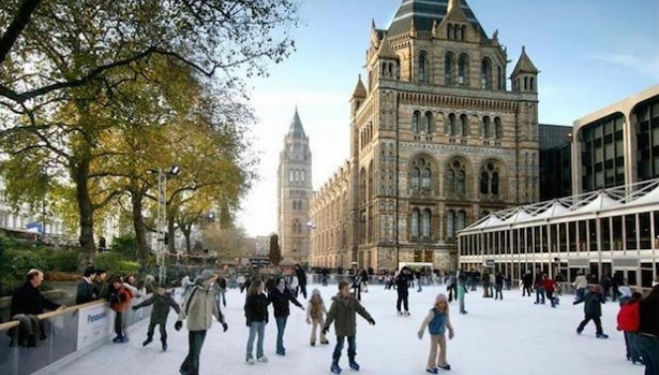
Winter might just be best time of year to visit the Natural History Museum, what with the wonderful ice rink just outside those vast Victorian doors and the new Café Bar offering hot drinks and snacks to stragglers.
But if skating's not for you, don't worry, because the museum is designed to enthral families all year round with the largest natural history collection in the world and over 80 million specimens from around our planet. Little scientists can get their teeth into the earth's geological past, learn about the future of our solar system and - best of all - admire the dazzling array of animals on Earth, taxidermied birds and mammals, 34 million glittering insects and arachnids and a vast array of fossils.
The Natural History Museum is probably most famous for its dinosaur skeletons and the enormous and affectionately named 'dippy' the dinosaur who greats visitors in the grand entrance (who, scandalously, will be replaced by a life sized blue-whale skeleton by summer 2017).
There's also a dino-exhibition, fit with moving dinosaur models, and the blue zone, in which a life-sized cast of the blue whale shows off it's mind-boggling size as the largest animal on our planet. Enter the earthquake simulation in the Restless Surface area at your own peril, remember to hold on to your children tight if you choose to enter the danger zone. Lastly, if the Victorian taxidermy seem a little off-putting to adult eyes, take solace in the knowledge that these very old, very dead creatures give children the extraordinary opportunity to ogle at long extinct animals from around the planet, including a dodo.
The NHM first opened its doors to the public in 1881. Its rich Victorian heritage and reputation for scientific excellence have made it one of London's most famous landmarks, the must-visit spot for animal lovers, wannabe astronauts and natural-scientists to-be.
For more kids events on at the Natural History museum, click here.
Suitable for children aged 2+
But if skating's not for you, don't worry, because the museum is designed to enthral families all year round with the largest natural history collection in the world and over 80 million specimens from around our planet. Little scientists can get their teeth into the earth's geological past, learn about the future of our solar system and - best of all - admire the dazzling array of animals on Earth, taxidermied birds and mammals, 34 million glittering insects and arachnids and a vast array of fossils.
The Natural History Museum is probably most famous for its dinosaur skeletons and the enormous and affectionately named 'dippy' the dinosaur who greats visitors in the grand entrance (who, scandalously, will be replaced by a life sized blue-whale skeleton by summer 2017).
There's also a dino-exhibition, fit with moving dinosaur models, and the blue zone, in which a life-sized cast of the blue whale shows off it's mind-boggling size as the largest animal on our planet. Enter the earthquake simulation in the Restless Surface area at your own peril, remember to hold on to your children tight if you choose to enter the danger zone. Lastly, if the Victorian taxidermy seem a little off-putting to adult eyes, take solace in the knowledge that these very old, very dead creatures give children the extraordinary opportunity to ogle at long extinct animals from around the planet, including a dodo.
The NHM first opened its doors to the public in 1881. Its rich Victorian heritage and reputation for scientific excellence have made it one of London's most famous landmarks, the must-visit spot for animal lovers, wannabe astronauts and natural-scientists to-be.
For more kids events on at the Natural History museum, click here.
Suitable for children aged 2+
| What | The Natural History Museum |
| Where | Natural History Museum, Cromwell Road , SW7 5BD | MAP |
| Nearest tube | South Kensington (underground) |
| When |
01 Nov 15 – 30 Sep 16, 10:00 AM – 5:50 PM |
| Price | £Free |
| Website | Click here for more information |




